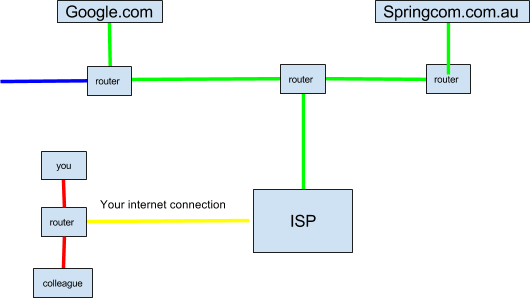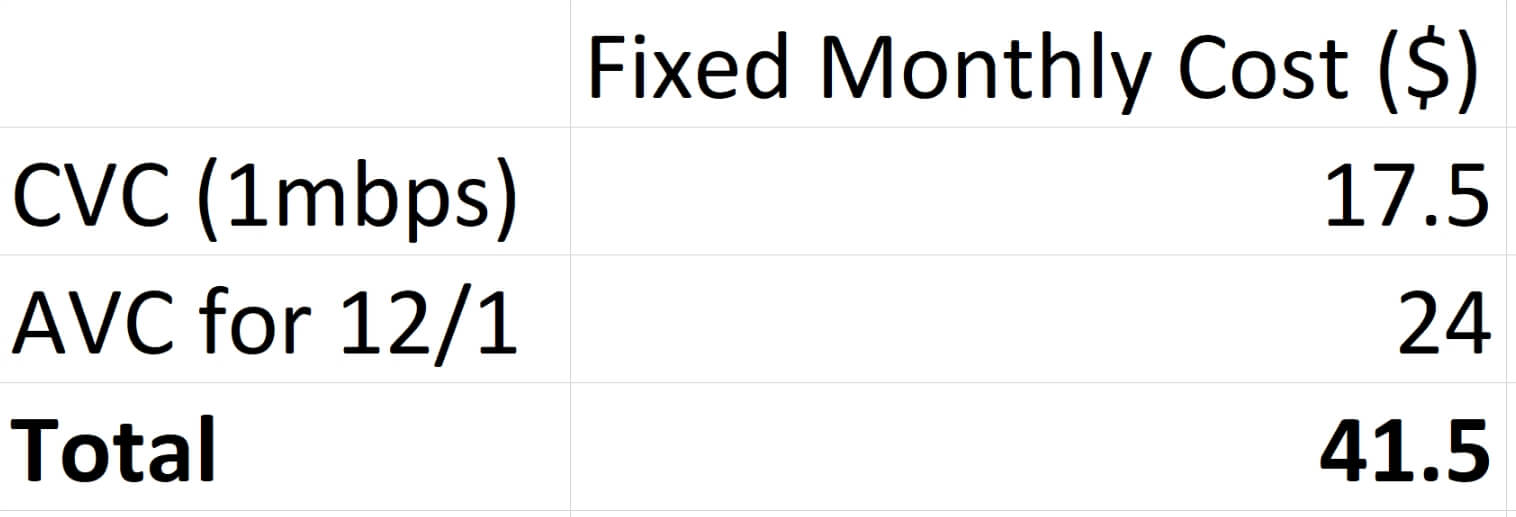In this article, we will go through how NBN package pricing works. And reveal how some internet service providers (ISPs) are charging just $29.99 for an NBN service while others charge $49.99 upward for the same advertised speed.
As irrelevant as this might seem, it’s critical that you know what you are actually getting when investing in an NBN provider – as the underlying service they provide you will affect your business daily.
The rollout of the NBN is forcing all businesses to move their entire business communications to the internet – which includes your phone service(s) running via VOIP and SIP over the internet. So having an internet service that can handle all your data requirements (both phone & general internet usage) will be critical to your business.
In this article we will explain the costs involved in providing an NBN service, and how some providers can put together internet packages cheaper than even ADSL packages.
How The Internet Works
In order to understand why your internet service is priced the way it is, we have to get a basic understanding of how the internet actually works; while most of us use it every day, not many of us actually know the mechanics.
The internet actually gets to you via a wire of some kind. For the past 20 years or so, most of us have been using internet delivered by copper wires. Now that the NBN is here in Australia, it’s delivered to most of us with underground fibre optic cables doing most of the heavy lifting. When we’re away from a fixed internet service our smartphones and tablets rely on the 4G network. And for those of us who live in rural and remote areas, the NBN is delivered from fixed wireless towers or the Sky Muster satellite.
Whether you are connected to the internet with a physical wire or an invisible beam, the internet means two computers can connect to each other using servers that are connected to that wire or beam.
Servers are specialised computers that are connected directly to the internet, and they store web pages on their hard drives. Every server has an Internet Protocol (IP) Address, and these help computers locate each other on the internet. These are complex numbers, so instead of remembering the numbers, we give them names, for example, www.springcom.com.au and www.google.com.
The Role of Internet Service Providers (ISP’s)
Your computer at home is not connected directly to the internet like the server examples mentioned above. Instead, your computer is indirectly connected through an Internet Service Provider (ISP).
Consider the diagram below. When you type a web address into your computer, say, google.com, your computer will connect with your ISP server (yellow), which then connects to the internet (blue line) and locates the IP address you were searching for (green line).

Packets
Whenever information is sent over the internet, whether it be a photograph, facebook status update, video or email, the internet breaks the information apart into what are called ‘packets’. These packets travel the internet and then, once they have reached their destination, are reassembled into their original format.
The Purpose of Routers
Every individual device that connects to the internet has it’s own IP address, including your laptop, PC, smartphone, and television. In your office there may be tens or hundreds of computers that are all connected to the same router, however, each of those computers has it’s own IP address.
Whenever two or more devices are intersecting to connect to a server, there is a router. They direct packets around the internet, making sure that information gets to it’s correct destination. There can be several routers that help get your packets to and from a server.

That’s why, when you and your colleagues are all using the internet at the same time, the information requested on each device does not appear on somebody else’s (which could get awkward).
How the Internet Gets from Your Office To ‘The Internet’ Via An NBN Connection
When you connect to the internet via the NBN, your connection goes through a number of steps.
These are:
- Your Office >
- Fiber Distribution Cabinet/Hub (Fiber to the Premises & HFC Only) >
- Fiber Access Node (FAN) >
- Point of Interconnect (POI) >
- Central Distribution Hub >
- The Internet

As you can see there are a number of steps your data has to go through to get from your office through the NBN network to reach the outside world. There are many variables through this process most notably the type of NBN connection your office has, and this is why NBNco are keen to point out that the NBN is an ‘up to, best effort service’.
There are also many other factors that go into the speed and reliability of the NBN and other data services you receive including, quality of hardware and ISP has in the POI’s, having failover or backup hardware in the POI’s, the number of ‘hops’ your internet request has to make to find it’s destination with the information you want (server) & the type of traffic class you opt for when choosing an NBN package.
The Costs Of Providing An NBN Service
While we generally only think of the final monthly cost for us as businesses when purchasing an internet service. There are actually several mandatory costs that your ISP has to pay before they can even offer you a service.
When you look at the different prices that ISP’s charge on an NBN or other data services that seems to offer the exact same advertised speeds & benefits, you may think the more expensive services & ISP’s are just trying to get more of your money simply because they can. The truth is, the price differences have a lot to do with how the ISP purchases their internet, which affects the quality of what ends up getting to you.
There are three mandatory costs ISP’s must pay NBNco and implement to sell an NBN service to businesses & consumers, these costs are the Connectivity Virtual Circuit Charge, Access Virtual Circuit Charge & Point of Interconnect. Let’s have a look at the three mandatory costs involved for ISP’s providing an internet service in more detail.
Connectivity Virtual Circuit (CVC)
The Connectivity Virtual Circuit (CVC) is a virtual fee that NBN. Co charges all internet ISP’s. It is not a charge for physical hardware for example cabling or wiring, but rather it is the charge levied against resellers (your ISP’s) for the maximum amount of bandwidth they want to make available to ALL of their NBN customers. The CVC is charged at $17.50 per Mbps the ISP buys (reserves) for their customers from NBNco.
The amount of CVC an ISP reserves for each of their customers is an integral factor in the quality of the NBN service that you – the end user – actually receives because the ISP decides how much of their overall Mbps purchase they want to allocate to each of their customers.
If an ISP provider purchases 1Mbps for every new customer it gets, it means that if every single customer were to use their internet at the same time, they would all be able to access the 1Mbps download speed. However, if an ISP provider only reserves 0.5Mbps per customer and, all their customers are using the internet at the same time, the maximum speed they will get is 0.5Mbps.
As you can see, how your ISP chooses to allocate their CVC load can affect you as the end user. However, that’s not the end of the story when it comes to charges your ISP has to pay to provide a service.
Access Virtual Circuit (AVC)
The Access Virtual Circuit (AVC) is another charge NBNco charges ISP’s. However, unlike the CVC, it is charged on a per connection basis, and priced based on the connection speed. Below is a simplified table of AVC charges broken down by connection speeds.

Point of Interconnect POI
The Point of Interconnect (POI) are physical connection points that allow all ISP’s to connect to NBN. Co, so that they can then connect their customers to the NBN. They are the modern day equivalent of ‘telephone exchanges’ – the place where our old telephone and ADSL services connected using copper wiring. As a matter of fact, there are 126 POI’s across Australia, of which most of them are placed within the old Telstra phone exchanges.
Each ISP has to pay for every POI they want to use to connect their service to the NBN. The setup fee charged by NBN Co.
On top of the setup fee charged to ISP’s to connect to each POI, they also incur a monthly fee payable to NBNco to maintain their connection that can run in the tens of thousands per POI connection.
On top of the setup and monthly fees, ISP’s also have to purchase the hardware (that can vary hugely in quality and reliability) that they install in each POI they provide a service from.
If you’ve ever seen an ISP that only services a small area, the reason is that they have only bought the right to use certain POI points across Australia.
Now that we’ve looked at the cost for ISP’s to gain access to an NBN service, let’s take a close look at why different providers charge different prices.
ISP’s All Have The Same Fixed Costs
Above is a summary of the investment ISP’s must make to provide a NBN Internet service to customers. Although there are some savings for ISP’s who bulk buy from the NBN, the savings are very small per customer they bring onto their service. So essentially All ISP’s have to pay the same amount per customer they have for the service they provide.
So let’s look at just the fixed monthly costs involved in providing a 12 Mbps download and 1mbps upload speed, where the ISP reserves 1Mbps/ per customer on their network.
(These costs are before the charge to an ISP for access to a POI and the cost for the hardware they have inside the POI.)

So every month your ISP has to pay $41.50 to provide a 12mbps download / 1mbps upload.
Now let’s look at how much it costs to provide a 100 Mbps download 40 Mbps upload service, where the ISP reserves a minimum of 2mbps per customer.

To provide this service the ISP has $73 of fixed charges.
A Cheap NBN Service vs ‘Expensive’ NBN Service
Now we know how much it can cost to provide an NBN service, you may be asking yourself, how if it costs $41.50 in just fixed monthly costs per customer to provide a 12/1 NBN service, how can ISP’s advertise and provide services from as little as $29.99 a month and still make a profit?
First, one cost any ISP can’t change is the AVC cost per individual connection. So for a 12/1 connection that’s $24. This only leaves the ISP $5.99 of profit before any other cost they have to provide the service. However, the ISP still needs to buy bandwidth for the customer to use. Reserving a minimum of 1mbps per customer costs the ISP $17.50 a month, and it is clear to see that that maths is never going to work.
However, if an ISP only reserves 0.2mbps per customer of bandwidth this means the effective CVC cost per customer is $3.50. As you can see this still leaves very little room for any other costs the ISP has such as customer service and other hardware costs.
This practice of only reserving very small amounts of bandwidth per customer can be used across every type of package to bring down the fixed monthly costs down of providing an NBN service to an individual customer.
What Does This Mean For Customers?
When you connect to the internet at an off-peak time of day, for example, 6am before anyone else is up and at work, there is going to be more than enough bandwidth across an ISP’s network to give you the bandwidth to take advantage of the access speeds you paid for.
However, when everyone arrives to work and is jumping on the internet to start their working day and the kids are at home streaming the latest shows, the amount of bandwidth to go around per customer starts having to be divided up between customers. And the maximum amount of bandwidth customers can get at that second is greatly reduced, and depending on how much bandwidth the ISP has reserved per customer, the internet could slow right down to dial-up internet speeds!
This phenomenon is known as congestion.
NBN Congestion
As mentioned above, the quality of your internet service is dependent on the amount of bandwidth (CVC) your provider has reserved per customer. If a provider were to purchase only a small amount of CVC, and attach a large number of connections to it, it can become congested.
Think of a large concert hall containing an audience of 800 people, and 8 exit doors. When the concert is over and it’s time for the audience to leave, opening only one door would create congestion and slow the entire process of emptying the hall. Opening all 8 doors would mean that people could exit faster, and the hall would be empty sooner.
Now, imagine that concert hall is your provider’s CVC load. If your provider chooses to purchase access to only one CVC (like opening the one door), and then connects 800 customers, the connections will become congested and the internet service will slow down. If, however, the provider connects 800 customers to 8 CVC’s (like opening all 8 doors), then clients will actually get faster access and a more reliable NBN service.
The reason CVC and AVC are important is because, with all service providers in Australia purchasing the same product (the NBN), what sets them apart is how much CVC they purchase, and how they choose to allocate and deliver it to each of their customers.
Contention Ratio
In the telco and data world the number of customers vs available bandwidth an ISP provides them is called the contention ratio.
The definition of Content Ratio is:
“Contention Ratio (or over subscription ratio) is the number of users sharing the same data capacity. The lower the contention ratio the higher the quality of service. A 50:1 contention ratio means that up to 50 broadband customers are sharing the same bandwidth at any one time.”
Conclusion
In this article, we have covered the charges ISPs must pay to provide an NBN service, and how these costs translate to the quality of service provided.
When you are looking for an NBN solution for your business, it’s important to keep in mind that you are going to get what you pay for. If the quality of your communications and productivity are important for your business, cheaper is unlikely to be better.
To learn more about how the NBN will affect your business, with help on how to transition your phone system to the NBN call our team on 1300 889 792.







